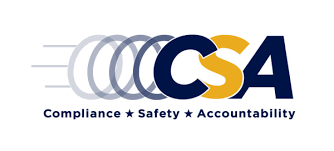It’s approaching nine years since the Federal Motor Carrier Safety Administration implemented the Compliance, Safety, Accountability program.
Although quite controversial in the beginning, CSA has taken a back seat to other pressing trucking issues such as electronic logging devices and the need to revise Hours of Service.
Given the fact that driver turnover remains quite high, we suspect that there are a lot of newer drivers — and we suspect even some veteran drivers — need a refresher course on how to traverse the pathways of CSA, all of which can lead to frustration, disappointment and yes, even exhilaration.
This is especially true of owner-operators who don’t have the information available to carrier drivers.
Compliments of ATBS, here’s that refresher.
The CSA program has gone through a lot of scrutiny over the past few years and many changes have been made to the program. However, scores are still being tracked by the Federal Motor Carrier Safety Administration. Even with the changes, can CSA scores still be used as a way to seriously measure safety and compliance? What follows in a primer on CSA so you can learn a little more about the CSA program and whether or not CSA scores still matter.
In December of 2010, the FMCSA implemented the Compliance, Safety, Accountability (CSA) program. This program was put into place as a way to measure safety and compliance on the road. The goal of the program is to improve safety while limiting the number of accidents involving commercial vehicles. Because the CSA program uses a scoring system owner-operators are able to see how they are doing in terms of safety and compliance by looking at how high or low their CSA score is.
How are scores calculated?
CSA scores are calculated by looking at the safety events of on owner-operator and categorizing them into Behavioral Analysis and Safety Improvements Categories (BASICs). The seven BASICs of safety are:
- Unsafe Driving
- Crash Indicator
- Hours of Service Compliance
- Vehicle Maintenance
- Controlled Substances/Alcohol
- Hazardous Materials Compliance
- Driver Fitness
Once the event has been placed into a category, it’s given a weighted score based on the severity of the event and how long ago it occurred. This data is updated monthly on the FMCSA’s Safety Management System (SMS). The lower the score, the better you are considered in terms of safety and compliance. Also, owner-operators must be aware that if they have a CSA score of 65 or above, they will receive a warning letter from the Motor Carrier Early Intervention protocol. This letter allows owner-operators to make the necessary corrections before safety problems become too severe and law enforcement has to step in.
Here are examples of violations at different point totals:
- 10-point violation: Going 15 or more miles above the speed limit
- 8-point violation: Driving a commercial vehicle without a CDL
- 5-point violation: Improper lane change
- 2-point: Lacking physical qualifications
Once a violation has occurred and a score has been given, that score is then multiplied based on how recently the violation occurred. If a violation occurred within the past six months, it’s multiplied by three. If a violation occurred between six to 12 months, it’s multiplied by two. Violations that occurred between 12 and 24 months are not weighted. After two years, violations are completely removed from an owner-operator’s record.
Where can I check my score?
CSA scores can be checked online at www.csa.fmcsa.dot.gov with your USDOT number and PIN. If you discover incomplete or incorrect information on your record, you can challenge the results by submitting a request for review at www.dataqs.fmcsa.dot.gov.
Do CSA Scores still matter?
In December 2015, President Barack Obama signed the Fixing America’s Surface Transportation Act (FAST Act), a five-year bill that governs federal surface transportation spending in the U.S. One of the biggest impacts the FAST Act had on the trucking industry was the FMCSA being forced to remove the BASICs from public view. This move was seen as a positive for those that believed the CSA scoring system was inaccurate and unreliable because of many shortcomings.
However, after significant changes and updates, five of the seven BASICs are once again publicly available online (Crash Indicator and Hazardous Materials Compliance are not available to the public). The only people who can see all seven of the BASICs are owner-operators looking at their own score and law enforcement. This means that your CSA score is still important for a variety of reasons:
- Owner-operators can use the scores to see where they stand in terms of safety and compliance. If they notice they have a high score, they can see what is causing this and put more emphasis in these areas in order to lower their score.
- Law enforcement can issue interventions to owner-operators based on their high scores. These interventions can lead to inspections and audits that are difficult, time-consuming, and costly.
- Even though the DOT maintains they never intended CSA scores to be used for these purposes, customers have chosen to work with owner-operators based on their CSA scores and insurance companies have charged higher premiums to owner-operators because of their high scores.
How can scores be improved?
Violations are completely removed after two years, which means if you have a high CSA score now, you have the ability to make it better. CSA scores can be improved over time by knowing what you are being scored on and operating on the road according to this information. The best way to do this is to set up a plan for yourself that focuses on safety and compliance. A good plan will include an initial training for yourself, consistent follow-up training to make sure you are still being compliant, and one-off training if you notice violations that you are commonly committing. The most common CSA violations have to do with lights, brakes, tires, speeding, and medical issues, so, when you begin training, make sure to add emphasis to these violations.
If you’ve paid attention to your CSA score and are happy with it, keep doing what you’re doing. If your score is high because you didn’t realize it still matters, you have the opportunity to lower it over time. With determination and a plan in place, you will be able to improve your CSA score.
The Trucker News Staff produces engaging content for not only TheTrucker.com, but also The Trucker Newspaper, which has been serving the trucking industry for more than 30 years. With a focus on drivers, the Trucker News Staff aims to provide relevant, objective content pertaining to the trucking segment of the transportation industry. The Trucker News Staff is based in Little Rock, Arkansas.







